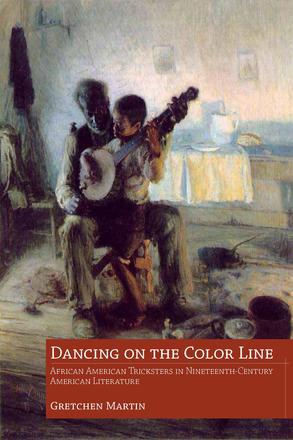
Dancing on the Color Line
African American Tricksters in Nineteenth-Century American Literature
A vivid canvas of how the black trickster affected the white canon
Description
The extensive influence of the creative traditions derived from slave culture, particularly black folklore, in the work of nineteenth- and twentieth-century black authors, such as Ralph Ellison and Toni Morrison, has become a hallmark of African American scholarship. Yet similar inquiries regarding white authors adopting black aesthetic techniques have been largely overlooked.
Gretchen Martin examines representative nineteenth-century works to explore the influence of black-authored (or narrated) works on well-known white-authored texts, particularly the impact of black oral culture evident by subversive trickster figures in John Pendleton Kennedy's Swallow Barn, Harriet Beecher Stowe's Uncle Tom's Cabin, Herman Melville's Benito Cereno, Joel Chandler Harris's short stories, as well as Mark Twain's Adventures of Huckleberry Finn and Pudd'nhead Wilson.
As Martin indicates, such white authors show themselves to be savvy observers of the many trickster traditions and indeed a wide range of texts suggest stylistic and aesthetic influences representative of the artistry, subversive wisdom, and subtle humor in these black figures of ridicule, resistance, and repudiation.
The black characters created by these white authors are often dismissed as little more than limited, demeaning stereotypes of the minstrel tradition, yet by teasing out important distinctions between the wisdom and humor signified by trickery rather than minstrelsy, Martin probes an overlooked aspect of the nineteenth-century American literary canon and reveals the extensive influence of black aesthetics on some of the most highly regarded work by white American authors.
Reviews
"Dancing on the Color Line delivers one of the most observant analyses of Jim's [Adventures of Huckleberry Finn] portrayal ever to have appeared in print. . . . From cover to cover, Dancing on the Color Line proves itself to be a crucial study for appreciating the subtlety of Mark Twain's achievements in racial perspectives on the subject of human slavery depicted in American fiction."
- Mark Twain Journal
"Martin adds to the discussion of race in US fiction an understanding of how the African trickster figure is intertwined with the plots and characters of the works involved, thus shaping the author's sympathies in important ways. With the volume, Martin adds a valuable layer of sophistication of discussion of race in American literature."
- Choice
"Through an impressive and precise analysis of the novels, Martin demonstrates how these white authors borrow from the black aesthetic technique of signifying (also referred to as 'Signiyin(g)' or 'signifyin') to represent their black characters. To support her argument, she ingeniously merges sources of literary analysis, folklore, personal narratives of slaves, and history in a meticulous analysis of folklore within the narrative to reveal the complexity of southern American literature starring black people and the cultural exchanges between black and white culture."
- Genia Boivin, Journal of Folklore Research
"Dancing on the Color Line explores the familiar world of nineteenth-century US writing about race to defamiliarize it by suggesting its hybrid nature. Through Martin's careful readings, well-known figures emerge as deeply influenced by the aesthetics and techniques of African American storytelling, and their literature reveals multiple trickster figures who turn a critical eye on the white power that frames them. Martin's readers encounter the fiction she discusses differently and with more attention to the complexity of the historical and literary context in which it was created."
- Kathryn McKee, McMullan Associate Professor of Southern Studies and English at the University of Mississippi and coeditor of American Cinema and the Southern Imaginary
"Dancing on the Color Line is a significant contribution to nineteenth-century American literary and cultural studies. Original, illuminating, and meticulously researched, Martin's book examines texts of John Pendleton Kennedy, Harriet Beecher Stowe, Herman Melville, Joel Chandler Harris, and Mark Twain, showing how these writers assimilated and employed black aesthetic strategies of 'signifying' and 'double voice' associated with the trickster figure. Martin lays the groundwork for further scholarly inquiry, particularly regarding possible lines of influence of minority American writers on modern and postmodern canonical authors and their works."
- Ed Piacentino, emeritus professor of English at High Point University and editor of Southern Frontier Humor: New Approaches, published by University Press of Mississippi
"Martin has proven to be one of our most important scholars in American humor and culture. Wherever she focuses her attention, and brings to bear her critical intelligence, new insights and useful ideas emerge. Dancing on the Color Line is a thoughtful and enlightening study of the African American trickster figure. The result is a solid contribution to both African American studies and our understanding of the continuously complex nature of American humor."
- M. Thomas Inge, Blackwell Professor of Humanities at Randolph-Macon College and author of many works on American humor, southern culture, comics art, and William Faulkner